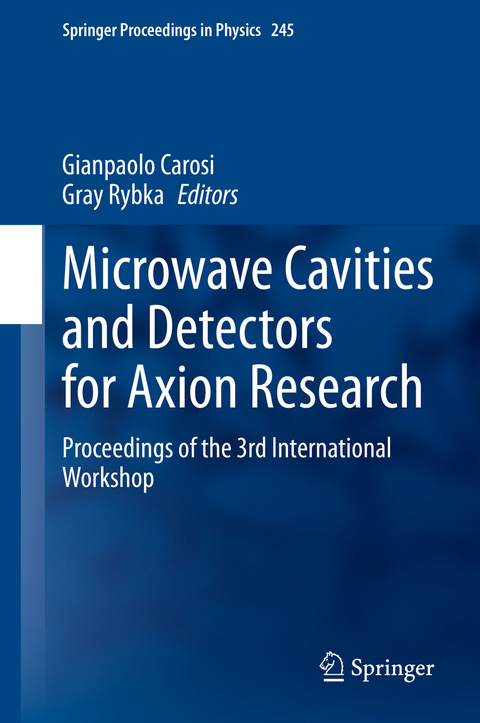
Microwave Cavities and Detectors for Axion Research
Springer International Publishing (Verlag)
978-3-030-43760-2 (ISBN)
Dr. Gianpaolo Carosi is a staff scientist at Lawrence Livermore National Laboratory (LLNL) with a primary research focus in direct dark matter axion searches and quantum detector development. Dr. Carosi obtained his Bachelors in Physics from Harvey Mudd College (2000) and a Ph.D in Physics from the Massachusetts Institute of Technology (2006). His thesis focused on indirect dark matter searches with the AMS Cosmic Ray experiment, currently sited on the International Space Station. Dr. Carosi worked as a postdoctoral researcher on the Axion Dark Matter Experiment (ADMX) at LLNL starting in 2006 and transitioned to staff in 2009. He is currently Co-spokesman of the ADMX experiment, now a DOE Office of Science "Generation 2" Dark Matter Project. He is a DOE Early Career Research Award recipient (2012-2017) with a focus on Microwave Cavity development for dark matter axion searches. He has led the organization of both the current workshop outlined in this proceedings proposal and the previous workshop (last held at LLNL in Aug 2015). In addition to his work on axion research, he is involved in research on superconducting quantum sensors and has worked in the past on national security applications involving fast neutron detection and gamma-ray imaging. Dr. Rybka Gray is an assistant professor at the University of Washington Department of Physics. He received his BS from Caltech in 2002 and his PhD in experimental particle physics from MIT in 2007. He is co-spokesperson for the ADMX experiment, now a DOE Office of Science "Generation 2" Dark Matter Project. He co-organized the workshop outlined in the proceedings. In addition to axion dark matter, Dr. Rybka played a key role in the development of Cyclotron Radiation Emission Spectroscopy (CRES) and is working actively on the Project 8 experiment to measure the neutrino mass scale. Dr. Karl van Bibber received his BS and PhD from MIT in experimental nuclear physics. After postdoctoral work at LBNL, he served as an Assistant Professor of Physics at Stanford. He joined LLNL where he founded and led the High Energy Physics and Accelerator Technology Group, and was LLNL Project Leader for construction of the SLAC-LBNL-LLNL PEP-II B Factory project. His institutional service includes positions as Chief Scientist for the Physics and Space Technology directorate, and Deputy Director of the Laboratory Science and Technology Office. In 2009 he became Vice President and Dean of Research of the Naval Postgraduate School in Monterey, CA. In 2012 he joined the faculty of UC Berkeley as Professor of Nuclear Engineering, and acceded to Department Chair in July 2012, serving also as Executive Director of the Nuclear Science and Security Consortium, a DOE Office of Non-Proliferation center-of-excellence. In July 2017, he was appointed Associate Dean for Research in the College of Engineering. His research focuses on basic and applied nuclear science, particle astrophysics, and accelerator science and technology. He is the recipient of an Alfred P. Sloan Research Fellowship, the DOE Deputy Secretary Award for the SLAC-LBNL-LLNL PEP-II B Factory accelerator, and the Navy Superior Civilian Service Award for the establishment of degree and executive education programs in Energy, the first within the DoD. He is a fellow of the APS and AAAS.
Chapter1. Microwave Cavity Simulation Using Ansys HFSS.- Chapter2. Ultra High Field Solenoids and Axion Detection.- Chapter3. Recent Results with the ADMX Experiment.- Chapter4. The Microstrip SQUID Amplifier in ADMX.- Chapter5. The ORGAN Experiment - Ben McAllister.- Chapter6. The 3 cavity prototypes of RADES, an axion detector experiment using microwave filters.- Chapter7. Reaching the 5--9 mieV Range with ADMX: Multi-Cavity Array.- Chapter8. High-Q 3D Photonic Bandgap Cavities for Axion Detection.- Chapter9. Magnetic shielding and source-mass characterization in the ARIADNE axion experiment.- Chapter10. CAPP-PACE experiment with a target mass range around 10 µeV.- Chapter11. ADMX HiRes Analysis.- Chapter12. Operation of a ferrimagnetic Axion haloscope at ma = 58 microeV.- Chapter13. Overview of the Cosmic Axion Spin Precession Experiment (CASPEr).- Chapter14. Axion dark matter search at CAPP.- Chapter15. Multiple-cell cavity for high mass axion dark matter search.- Chapter16. Dark Matter Radio.- Chapter17. Axion Detection with Precision Frequency Metrology.- Chapter18. Quantum Oscillators and Bayesian Searches.- Chapter19. MADMAX: Introduction and status.- Chapter20. Orpheus: Extending the ADMX QCD Dark-Matter Axion Search to Higher Masses.
| Erscheinungsdatum | 09.07.2020 |
|---|---|
| Reihe/Serie | Springer Proceedings in Physics |
| Zusatzinfo | VIII, 175 p. 74 illus., 60 illus. in color. |
| Verlagsort | Cham |
| Sprache | englisch |
| Maße | 155 x 235 mm |
| Gewicht | 448 g |
| Themenwelt | Naturwissenschaften ► Physik / Astronomie ► Astronomie / Astrophysik |
| Naturwissenschaften ► Physik / Astronomie ► Atom- / Kern- / Molekularphysik | |
| Naturwissenschaften ► Physik / Astronomie ► Hochenergiephysik / Teilchenphysik | |
| Naturwissenschaften ► Physik / Astronomie ► Thermodynamik | |
| Schlagworte | accelerator cavities • amplifier technology • axon-to-photon conversions • Dark Matter • designing microwave cavities for axion searchers • microstrip SQUIDs • primordial axion particles • Superconducting Detectors • superconducting quantum limited |
| ISBN-10 | 3-030-43760-4 / 3030437604 |
| ISBN-13 | 978-3-030-43760-2 / 9783030437602 |
| Zustand | Neuware |
| Haben Sie eine Frage zum Produkt? |
aus dem Bereich


